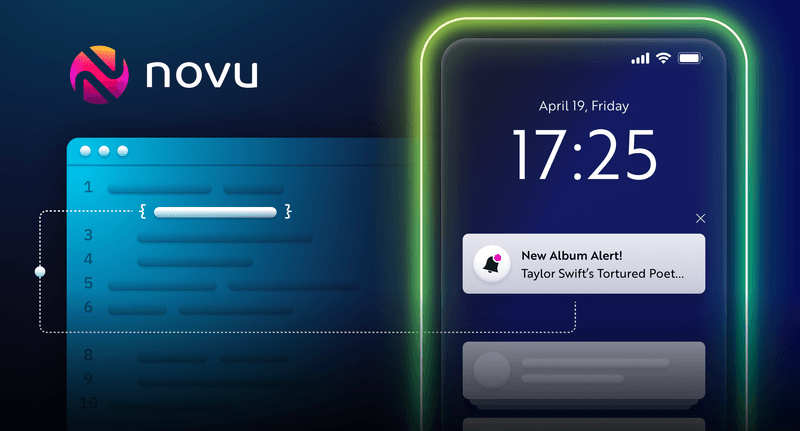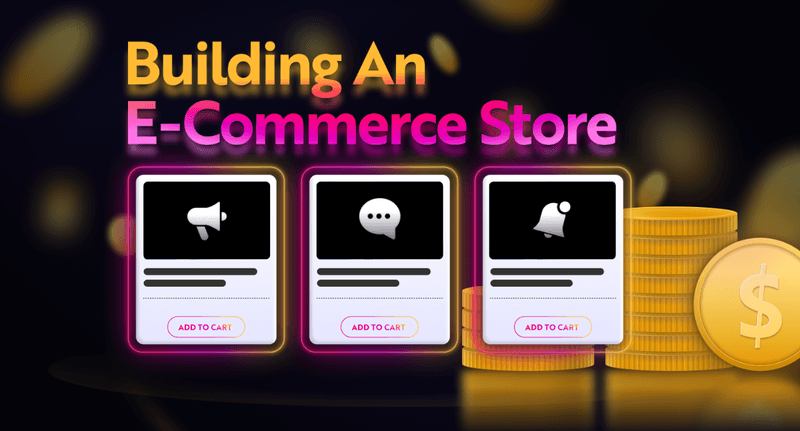How to Grow Engagement By Using Notifications
How to grow Product engagement by using Notifications


Notifications have become an integral part of modern software applications. Whether you need to notify users that their payment was successful via email, send social media push notifications about the latest trends, SMS notifications, or even in-app notifications, they have helped improve the user experience of various products and keep users active on these platforms.
In this article, you’ll discover the different types of notifications and their role in enhancing user engagement within software applications. You’ll also learn about Novu and how to use it to create dynamic and visually appealing modern notifications for your applications.
Types of Notifications
Notifications are alerts or proactive messages that inform users about recent events or activities within an application. They enable users to stay informed and engaged with the latest updates. Notifications can take various forms, depending on the method and device used for sending the alerts. They can be delivered as email, SMS, chat, push, in-app, or website notifications.
Let’s explain them in detail:

Email Notifications
Email notifications are simply messages sent via email. They are usually sent to the users’ email addresses to inform them about recent happenings or even notify them about the various events carried out within the application.
Email notifications are versatile and can include detailed information, rich media content, documents, and links to other resources, readily accessible at the user’s convenience. Email notifications may not require immediate actions from the user. It is often used for sending newsletters, promotions, order and payment confirmations, recent account activities, etc.
Emails also serve as a means of identification, allowing developers and application owners to share general and individual messages about upcoming activities and changes to user policies.
SMS Notifications
SMS notifications are short text messages sent directly to users’ mobile phone numbers over a cellular network. They are effective for two-factor authentication, delivering shortcodes for confirmation, appointment reminders, and transaction alerts.
SMS notifications can deliver urgent or time-sensitive messages due to their immediate delivery and high open rate. For instance, in some countries, such as the UK, the government sends text alerts to all mobile phones within the country before and during life-threatening disasters or emergencies.
SMS phone numbers can also help developers or application owners identify each user and determine their geographical locations using the country codes.
Chat Notifications
Chat notifications are alerts sent to users within a chat application. The notifications can be private messages, group messages, a mention, and many more. They are immediate and can contain multimedia, such as images, videos, audio, etc.
Chat notifications enable users to send and receive messages in real-time. They notify the participants within a chat group about the latest messages within the conversation. It is commonly used in chat applications, such as Discord, WhatsApp, Slack, Instagram, etc.
Push Notifications
Push notifications are messages sent from an application to a user’s device (mobile or web) to inform them about various events, updates, or activities within the application. These messages are delivered even if the application is not actively being used.
For instance, when you turn on your mobile data after it has been off for a while, messages that were pending delivery may start to pop up on your device. These are push notifications.
They can appear as badges or small pop-up messages that show the application name, icon, and part or all of the message’s content. They are highly effective in keeping users engaged within an application and are a key feature of every successful modern mobile application.
In-app Notifications
In-app notifications are alerts that appear within a mobile, web, or desktop application, informing users about recent activities within the application. These notifications are only visible when a user is actively using the application.
For instance, in a support ticketing system that handles customers’ queries, and sends a notification to each customer support personnel that a new support ticket has been created. The notification may be sent to staff who are currently online, enabling them to track and respond to each query promptly.
In-app notifications are also similar to the notifications bar on social media platforms like Facebook and LinkedIn, where you can view all recent posts and updates you may have missed since your last login or interaction with the application.
Website Notifications
Web notifications are messages that appear in a user’s web browser to inform you about updates, or activities on a website or web application. They can reach users even when they are not on the website and can include rich media and interactive elements. However, users need to grant permission to receive web notifications, and they can be blocked or ignored.
For instance, when you visit websites like X or YouTube on your computer, you may receive a prompt to subscribe to notifications. This allows you to receive notifications and access them directly within your web browser.
How Notifications can Enhance Engagements
Notifications are one of the best ways to keep users engaged with your application. By sending timely and relevant notifications about recent activities, users find the application more useful and are likely to spend more time on it.
Some of the ways in which notifications can help enhance engagement within applications include:
Timely Updates and Reminders
Sending real-time updates and relevant reminders can help improve user engagement within software applications. These notifications serve as a call to action, encouraging users to revisit the application and stay updated on recent happenings.
For instance, calendar apps send reminders about upcoming events, gaming applications notify users of new updates, and e-commerce apps alert users about discount sales, new arrivals, and the arrival of purchased items. This timely information keeps users in the loop and engaged with the application.
Personalised Notifications
Personalising notifications within an application can significantly improve user engagement. Depending on how users interact with the application, it can suggest various activities or updates that may interest them. Software applications can also analyse user data and send customised messages that resonate with users.
For example, a music streaming app might notify users about new releases from their favourite artists, or a social media app might use notifications to alert users about comments on their posts or new messages. This, in turn, increases user engagement within the application.
Improved User Experience
Notification is an essential component of every modern software application. Regular notifications can help build a habit of using the application and remind users of its existence, especially when the user does not need to use daily.
For instance, social media and mobile news applications can send push notifications about the recent happenings to keep users engaged. Additionally, software applications can send email messages to users regarding various activities such as onboarding guides, account activities, newsletters, and greeting messages. These consistent messages enhance the user experience and keep users active within the application.
Encouraging User Actions
Interactive and beautifully designed alerts can prompt users to take specific actions, such as completing a purchase or responding to a message. With clear call-to-actions or catchy content, users can be encouraged to engage with the application and perform the desired actions. Notifications nudge users towards specific actions, such as purchasing a discounted item, participating in an event, or reading an email with a catchy headline. These notifications help keep users active and engaged with the application.
Novu: Empowering Developers to Build Notification Products
Novu is a notification infrastructure tool that provides a unified API for sending notifications through multiple channels, including In-App, Push, Email, SMS, and Chat. It enables you to add multi-channel notifications to your application, create complex notification workflows, and monitor every notification activity from a single dashboard.
Novu also allows you to switch between different communication providers of your choice. It supports multiple email, SMS, push, and chat providers.
For instance, when configuring email notifications for your application, you can choose to use any email service provider, such as Resend, Mailtrap, Sendgrid, and many others. You can manage all of these changes directly from your Novu dashboard.

Why Choose Novu?
Novu provides a comprehensive platform for building notification systems, offering features such as a notification centre, workflow editor, and integration with multiple providers. Here are some of the features that make Novu stand out:
Unified API for multiple communication channels
Novu provides a single API for sending notifications through multiple channels, such as In-App, Push, Email, SMS, and Chat. This simplifies its integration process, enabling developers to add notifications seamlessly to software applications.
Additionally, Novu supports multiple programming languages, including Python, Go, Ruby, PHP, and Kotlin. This ensures that developers can create applications with complex or rich notification systems, regardless of their preferred programming language.
Prebuilt, customisable UI components
Novu allows you to integrate in-app notifications into your application by providing customizable components for your web clients. It currently supports React, Vue, Angular, Headless, and a custom Web Component that enables you to add in-app notifications into any framework or vanilla JavaScript project.
Real-time activity monitoring
Novu offers real-time monitoring and analytics, enabling you to track the delivery and performance of notifications. This can be useful when debugging notifications. For instance, you can detect when a communication provider is down and switch to another easily without leaving the dashboard and touching your application’s code.
Notification Content Management
Novu provides the ability to manage notification content from a central place. You can leverage your existing content tools and frameworks to build appealing and engaging notifications. Novu also allows your co-working teams such as product and marketing to manage content easily while the engineering team builds out the notification workflows.
Code First Notification Workflows with Novu
Novu enables you to create notification workflows within your codebase. It allows you to integrate email, SMS, chat templates, and content generators, such as React Email and MJML, into Novu to create advanced and powerful notifications.
Novu provides the option to set up notifications directly within your application and integrate your preferred notification templates into Novu to create complex notifications. This flexibility allows developers to build sophisticated notification systems tailored to the application’s needs.
Conclusion
Notifications are the key to every successful application, and Novu provides that key for building powerful, notification-rich software applications.
Novu makes it easy for you to send, monitor, and manage notifications across multiple communication channels. If you want to build an application that requires a Chat, SMS, Push, Email, or In-app notification, you should check out Novu.
Novu also provides a series of how-to guides in addition to its clear documentation to guide you through the process of adopting Novu. You can also join the community to contribute, chat with the maintainers and improve the software.
Thank you for reading!



